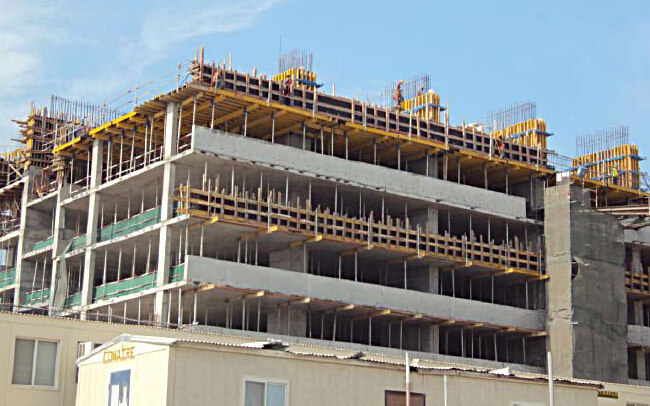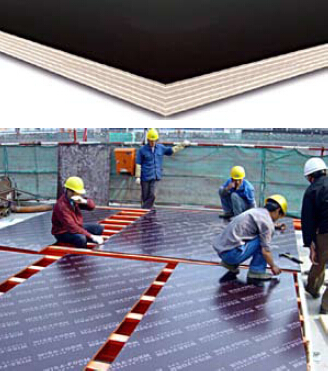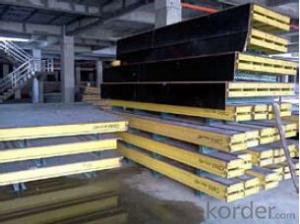Plywood formwork systems for formwork and scaffolding
- Loading Port:
- Tianjin
- Payment Terms:
- TT OR LC
- Min Order Qty:
- 50 m²
- Supply Capability:
- 1000 m²/month
OKorder Service Pledge
Quality Product, Order Online Tracking, Timely Delivery
OKorder Financial Service
Credit Rating, Credit Services, Credit Purchasing
You Might Also Like
Plywood --- make perfect concrete surface
WISA-Form Birch is a coated special plywood using in the formwork systems where high
requirements are set on the concrete surface and the times of reuses.
With CNBM timber beam & WISA plywood, the formwork is low weight but high load capacity, it is
widely used in construction.
Characteristics:
◆ Component with high standardization.
◆ Assembling in site, flexible application.
◆ Light weight, easy transportation and storage.


- Q:Can steel formwork be used for underground construction projects?
- Yes, steel formwork can be used for underground construction projects. Steel is a durable and strong material that can withstand the pressure and conditions found in underground structures. It provides stability and support during the construction process and can be easily reused or recycled after the project is completed.
- Q:What are the different types of connections used in steel formwork?
- There are several different types of connections commonly used in steel formwork, each with its own advantages and applications. Some of the most common types include: 1. Bolted connections: These connections involve using bolts and nuts to secure the formwork components together. Bolted connections are versatile, relatively easy to assemble and disassemble, and provide a high level of strength and stability. They are often used for larger formwork structures or where high loads are expected. 2. Welded connections: Welding is another popular method of connecting steel formwork components. Welded connections offer excellent strength and durability, as the pieces are fused together. However, welding requires skilled labor and specialized equipment, which can increase costs and time. 3. Clamped connections: Clamped connections involve using clamps or couplers to hold the formwork components together. Clamped connections are quick to assemble and disassemble, making them ideal for temporary structures or situations where frequent changes are required. They also offer flexibility in terms of adjusting the formwork components' position. 4. Pin connections: Pin connections involve using pins or dowels to join the formwork components together. These connections are relatively simple and can be quickly assembled or disassembled. However, pin connections may not offer the same level of strength as bolted or welded connections. 5. Adhesive connections: Adhesive connections involve using an adhesive or epoxy to bond the formwork components together. This type of connection is commonly used for smaller or lightweight formwork structures. Adhesive connections provide a strong bond and are often used in situations where welding or bolting is not feasible. Each type of connection has its own advantages and disadvantages, and the choice depends on factors such as the formwork structure's size, load requirements, desired level of strength, and project timeline. Consulting with a structural engineer or formwork specialist can help determine the most suitable connection type for a specific project.
- Q:How long does it take to set up steel formwork?
- The time it takes to set up steel formwork depends on various factors such as the complexity of the structure, the experience and skill level of the workers, the size of the project, and the availability of equipment. Generally, setting up steel formwork can take anywhere from a few hours to several days. For smaller projects with simple structures, a team of experienced workers can typically set up the formwork within a day or two. This includes measuring and marking the layout, assembling the steel panels, beams, and props, and securing them in place. The process may also involve attaching braces and ties to ensure stability and alignment. On the other hand, larger and more complex projects may require more time for formwork setup. This could involve intricate designs, multiple levels or floors, and a higher number of formwork components. In such cases, the setup process may take several days or even weeks, depending on the size of the team and the availability of resources. It's important to note that while steel formwork may take longer to set up compared to other types of formwork such as timber or plastic, it offers benefits such as durability, reusability, and better stability. These advantages outweigh the additional time required for setup, especially for large-scale construction projects that require strong and reliable formwork systems.
- Q:What are the common safety measures to be followed when using steel formwork?
- Some common safety measures to be followed when using steel formwork include: 1. Proper training: Ensure that all workers using steel formwork are properly trained on its installation, dismantling, and usage procedures. 2. Personal protective equipment (PPE): Workers should wear the appropriate PPE, including helmets, safety glasses, gloves, and steel-toed boots, to protect themselves from potential hazards. 3. Secure setup: Ensure that the steel formwork is properly secured and supported to prevent collapse or movement during construction activities. 4. Regular inspection: Regularly inspect the steel formwork for any signs of wear, damage, or instability. Replace or repair any faulty components immediately. 5. Fall protection: Implement fall protection measures such as guardrails, safety harnesses, and safety nets to prevent falls from elevated platforms or edges. 6. Safe lifting: Use appropriate lifting equipment and techniques to handle heavy steel formwork components to prevent strain or injuries. 7. Communication: Establish clear communication channels between workers to ensure everyone is aware of their responsibilities and any potential safety hazards. 8. Adequate lighting: Ensure that the work area is well-lit to minimize the risk of accidents or injuries due to poor visibility. 9. Housekeeping: Maintain a clean and organized work area, removing any debris or tripping hazards to prevent accidents. 10. Emergency preparedness: Have a well-defined emergency response plan in place and make sure all workers are aware of the procedures to follow in case of an emergency.
- Q:Can steel formwork be used in earthquake-prone areas?
- Yes, steel formwork can be used in earthquake-prone areas. Steel is a strong and durable material that can withstand the forces exerted during an earthquake. It has high tensile strength and can resist deformation or collapse under seismic loads. Steel formwork systems are designed to be rigid and stable, providing a safe and reliable solution for constructing buildings and structures in earthquake-prone regions. Additionally, steel formwork is reusable, making it a cost-effective option for construction projects in these areas. It is important, however, to ensure that the steel formwork is designed and installed according to the specific seismic requirements and regulations of the particular area to ensure optimal safety.
- Q:Are there any specific safety guidelines for steel formwork construction?
- Yes, there are specific safety guidelines that should be followed during steel formwork construction. Some of the key safety guidelines include: 1. Personal Protective Equipment (PPE): All workers involved in steel formwork construction should wear appropriate PPE, such as hard hats, safety goggles, gloves, and steel-toed boots. This helps protect against potential hazards like falling objects, flying debris, and impact injuries. 2. Fall Protection: Adequate fall protection measures should be in place to prevent falls from heights. This may include the use of guardrails, safety nets, or personal fall arrest systems (PFAS) depending on the height and nature of the work being carried out. 3. Structural Stability: Before starting the construction process, it is important to ensure that the steel formwork structure is stable and properly braced to prevent collapse or structural failure. Regular inspections should be conducted to identify any signs of weakness or damage and immediate corrective actions should be taken. 4. Proper Handling and Storage: Steel formwork components should be handled with care and stored in a secure manner to prevent accidents and injuries. Safe lifting techniques should be followed to avoid strains and muscle injuries. 5. Electrical Safety: If electrical equipment is being used during the construction process, it is important to follow electrical safety guidelines. This may include grounding the equipment, using proper insulation, and ensuring that electrical connections are secure. 6. Hazard Communication: All workers should be aware of the potential hazards associated with steel formwork construction, and proper communication and training programs should be in place to educate them about these hazards and the necessary safety precautions. 7. Regular Maintenance: Regular inspections and maintenance of the steel formwork system should be conducted to ensure its integrity and safe use. Any identified defects or damages should be repaired or replaced promptly. It is important to note that these guidelines may vary depending on the specific project, local regulations, and industry best practices. It is recommended to consult with industry experts and adhere to any additional safety guidelines that may apply to the specific steel formwork construction project.
- Q:How does steel formwork contribute to the overall structural stability of the building?
- Steel formwork contributes to the overall structural stability of a building in several ways. Firstly, it provides a strong and rigid framework that supports the weight of concrete during the pouring and curing process. This ensures that the concrete is evenly distributed and prevents any sagging or deformation. Secondly, steel formwork helps in maintaining the desired shape and dimensions of the concrete elements, such as columns, beams, and walls, which are crucial for the overall stability of the structure. Additionally, steel formwork offers high tensile strength and durability, allowing it to withstand the forces imposed by the concrete and any external loads, thus enhancing the structural integrity of the building.
- Q:Can steel formwork be used for both large and small construction projects?
- Yes, steel formwork can be used for both large and small construction projects. Steel formwork offers several advantages such as durability, strength, and reusability, which make it suitable for a wide range of projects. For large construction projects, steel formwork provides the necessary structural support to handle heavy loads and withstand the pressures of large-scale construction. Additionally, its ability to be easily assembled and disassembled allows for efficient construction processes. On the other hand, for small construction projects, steel formwork offers cost-effectiveness and flexibility. Its reusability allows for multiple uses, minimizing the need for additional formwork materials and reducing construction costs. Overall, steel formwork is a versatile option that can be adapted to meet the requirements of both large and small construction projects.
- Q:Does steel formwork require any special expertise or training for installation?
- Yes, steel formwork generally requires special expertise or training for installation. The process involves understanding the structural requirements, proper handling and assembling of steel components, as well as ensuring the formwork's stability and safety. Expertise in steel construction and knowledge of formwork systems are usually necessary for a successful installation.
- Q:How is steel formwork adjusted for different concrete thicknesses?
- Steel formwork is adjusted for different concrete thicknesses by using adjustable steel soldiers or props. These steel soldiers are placed vertically at regular intervals along the formwork, providing support and stability. By adjusting the height of these soldiers, the formwork can be raised or lowered to accommodate different concrete thicknesses. To adjust the formwork, the steel soldiers are typically equipped with threaded ends that can be screwed up or down. This allows the formwork to be easily raised or lowered to the desired height. The threaded ends of the soldiers are securely fixed into designated holes or slots on the formwork, ensuring stability and preventing any movement during the pouring and curing of concrete. Additionally, steel formwork systems often include adjustable formwork clamps or brackets. These clamps or brackets are used to secure the formwork panels together, ensuring they remain in the desired position and shape. By adjusting the positions and angles of these clamps or brackets, the formwork can be modified to accommodate variations in concrete thickness. Overall, the adjustable nature of steel formwork, through the use of steel soldiers, props, clamps, and brackets, allows for easy customization and adaptation to different concrete thicknesses. This flexibility ensures that the formwork can effectively contain and shape the concrete during the construction process, resulting in high-quality and structurally sound concrete structures.
1. Manufacturer Overview |
|
|---|---|
| Location | |
| Year Established | |
| Annual Output Value | |
| Main Markets | |
| Company Certifications | |
2. Manufacturer Certificates |
|
|---|---|
| a) Certification Name | |
| Range | |
| Reference | |
| Validity Period | |
3. Manufacturer Capability |
|
|---|---|
| a)Trade Capacity | |
| Nearest Port | |
| Export Percentage | |
| No.of Employees in Trade Department | |
| Language Spoken: | |
| b)Factory Information | |
| Factory Size: | |
| No. of Production Lines | |
| Contract Manufacturing | |
| Product Price Range | |
Send your message to us
Plywood formwork systems for formwork and scaffolding
- Loading Port:
- Tianjin
- Payment Terms:
- TT OR LC
- Min Order Qty:
- 50 m²
- Supply Capability:
- 1000 m²/month
OKorder Service Pledge
Quality Product, Order Online Tracking, Timely Delivery
OKorder Financial Service
Credit Rating, Credit Services, Credit Purchasing
Similar products
New products
Hot products
Related keywords
























